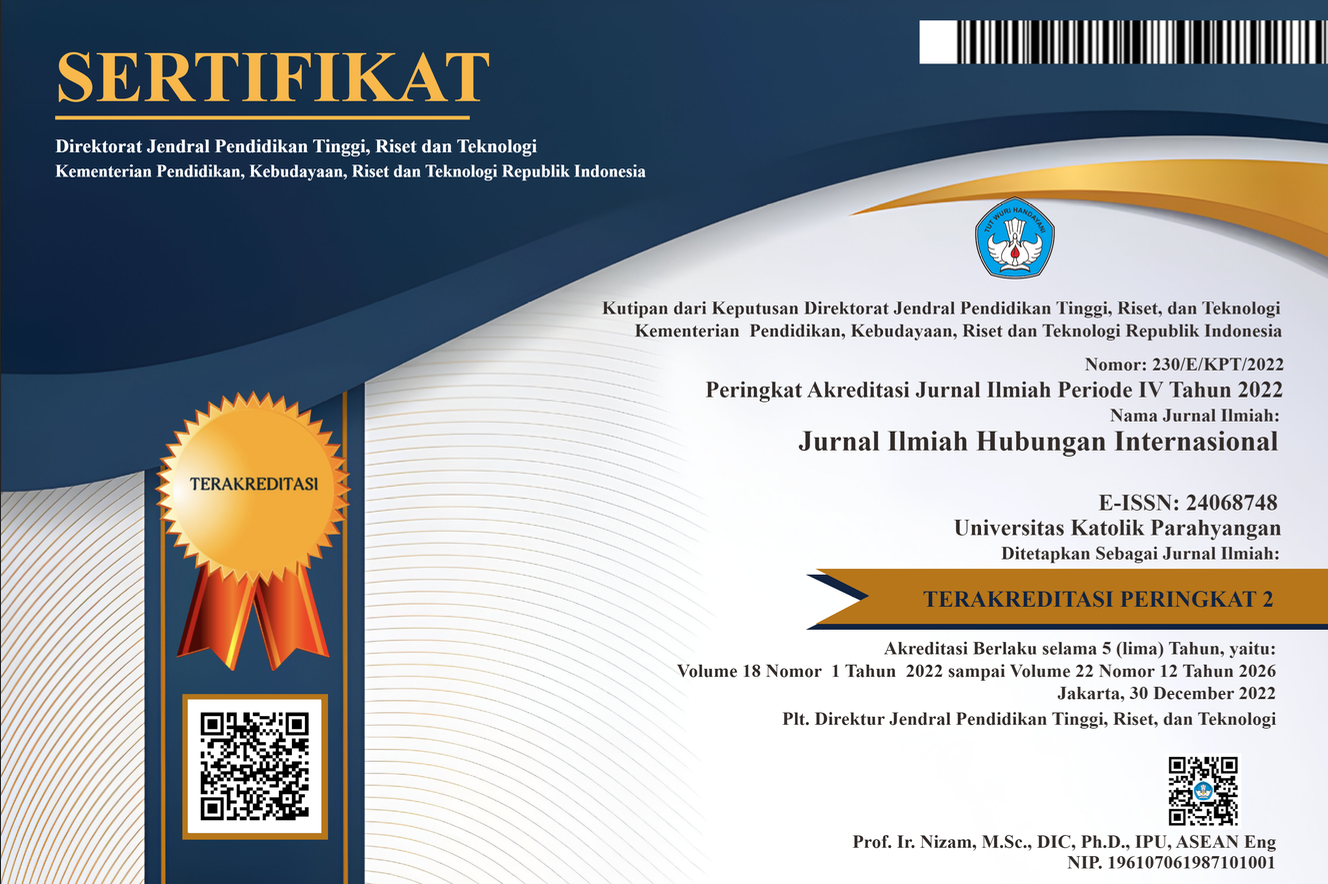Dialog dalam Resolusi Konflik-Interaktif
Abstract
Komunikasi merupakan hal yang penting dalam kegiatan apapun. Dalam kerjasama bahkan konflik membutuhkan komunikasi. Akan tetapi, komunikasi juga dapat menjadi sumber masalah apabila informasi yang disampaikan tidak diterima dan dipahami dengan baik. Banyak faktor yang dapat menghambat terjalinnya komunikasi dengan baik. Sesungguhnya, komunikasi dapat menjadi salah satu cara dalam melakukan resolusi konflik Tulisan ini akan menjelaskan dua pokok bahasan yang nantinya akan mendeskripsikan posisi dan peran dialog dalam meretas jalan perdamaian dengan studi kasus di Papua. Bagian awal dari tulisan ini memprioritaskan pembahasan pencarian pemahaman yang komprehensif mengenai dialog. Kemudian pada bagian kedua pembahasan akan difokuskan pada keterkaitan dialog dengan Resolusi Konflik-Interaktif (RKI).
References
Adejimola, Amuseghan Sunday, Language and communication in conflict resolution Department of Arts Education,Adekunle Ajasin University, Akungba-Akoko, Journal of Law and Conflict Resolution Vol. 1(1), pp. 001-009, June, 2009
Apel. Karl-Otto 1990. Diskurs Und Verantwortung, Frankfurt Suhrkamp. Dalam Norbert Ropers. 2003. From Resolution to Transformation: The Role of Dialogue Projects. Berghof Research Center for Constructive Conflict Management.
Brenner. L. Nurette 2011. The Field beyond Wrong Doing and Right Doing: A study of Arab-Jewis Grassroot Dialogue Group in the United States. Dissertation, Department of Organizational Behavior. Case Western Reserve University.
Bohm, David 2004. On Dialogue, diedit oleh Lee Nichol, New York, Rout ledge Classic.
Brett, M. Jeanne. 2007. Social Dilemmas, Negotiating Globally: How to Negotiate, Deals, Resolve Disputes, and Make Decisions across Cultural Boundaries. Springer Verlag.
Clark. H. Herbert. 1996. Using Language. Cambridge. Cambridge University Press.
Cohen, Raymond. 1991. Negotiating Across Culture; Communication Obstacles in International Diplomacy. Washington DC. USIP. Press.
C. Shannon, Weaver W. (1977). The Mathematical Theory of Communication in: W. Schram and D. F. Roberts. The Process and Effects of Mass Communication., Illinois: University of Illinois Press.
Fisher, J. Ronald 1997. Interactive Conflict Resolution. Syracuse University Press.
Fisher, Rojer dan William Ury, 1981. Getting to Yess: Negotiating Agreement Without Giving
Galtung. Johan. 2004. Saturday: Transcend and Transformed: An Introduction to Conflict Works. England, Pluto Press.
Hall T. Edward. 1959. The Salient Language. Garden City. New York. Doubleday.
Isaacs, William 1999. Dialogue and the Art of Thinking Together, New York Doubleday, Random House.
Kahn. Michael 1981. The Seminar: An Experiment on Humanistic Education. Journal of Humanistic Psychology. No. 21. 119-127.
Kolb, Deborah. 1994. The Reality of Making Talk Work, When Talk Work: Profiles of Mediators. Jossey Brass.
Mayer. Bernard, 2000. The Dynamics Of Conflict Resolution: A Practitioner’s Guide, San Francisco, Josey-Bass, A. Wiley Company.
Michell, Christopher dan Michael Banks, 1996. Handbook of Conflict Resolution: The analytical Problem Solving Apparoach. Pinter, Wellington House. London.
Nopers, Robert 2003. From Resolution to Transformation: The Role of Dialogue Projects. Berghof Research Center for Constructive Conflict Management.
Putnam. L. Linda Communication and Conflict Resolution, Department of Communication University of California, Santa Barbra.
Rothman Jay 1998. “Dialogue in Conflict: Past and Future”. Dalam Eugene Weiner 1998 (editor). The Handbook of Interethnic Coexistence, New York Continuum.
Scoot A. O., La Danse: The Paris Opera Ballet. The New York Times, Nove 6, 2009.
Tidwell C. Alan 1998. Conflict Resolved?: A Critical Assessment of Conflict Resolution, London, New York: Pinter Books.
Wong Edward dan Helenne Cooper, In Beijing, Obama Calls for ‘Strong Dialogue’. The New York Times, Nove 16, 2009.
Downloads
Published
How to Cite
Issue
Section
License
This journal uses Creative Commons license (CC BY). We allow readers to read, download, copy, distribute, print, search, or link to the full texts of its articles and allow readers to use them for any other lawful purpose. The author must be aware that the article copyrights will be fully transferred to Jurnal Ilmiah Hubungan Internasional only if the article is accepted to be published in the journal through signing of the Copyrights Transfer Agreement. Authors are allowed to resend their manuscript to another journal or intentionally withdraw the manuscript only if both parties (JIHI and Authors) have agreed on the related issue. Once the manuscript has been published, authors are allowed to use their published article under Jurnal Ilmiah Hubungan Internasional copyrights.








